|
ARTICLES
Top Ten Archaeological Excavations of 2004 | China Heritage Quarterly
LIST OF THE TOP TEN ARCHAEOLOGICAL EXCAVATIONS OF 2004
1. Beifudi prehistoric site, Yixian county, Hebei province
Date: neolithic
Excavation team: Hebei Provincial Cultural Relics and Archaeology Institute
Leader of the excavation: Duan Hongzhen

Pottery pig-faced mask found at the Beifudi neolithic site
Regarded as one of the most important prehistoric sites in Hebei, the stratigraphy of the site suggests that it was contemporary with Cishan and Xinglongwa archaeological cultures (i.e. 6000-5000 BCE). A number of dwelling foundations were found at the site and remains of what is described as an "altar". A large quantity of carved pottery masks (see illustration) were found, and these are the earliest example of this type of artefact found to date in China. The excavators suggest that the masks have a connection with shamanism and religious observances.
2. Qingliangsi cemetery site, Ruicheng, Shanxi province
Date: neolithic
Excavation team: Shanxi Provincial Cultural Relics and Archaeology Institute
Leader of the excavation: Xue Xinming
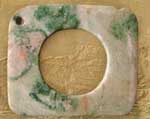
Jade bi disc found at the neolithic Qingliangsi cemetery site, Ruicheng, Shanxi province
The Qingliangsi cemetery is the first large cemetery of the neolithic Miaodigou II archaeological culture unearthed in China. More than 200 jade items were recovered, and archaeologists believe that these finds are critical for examining the origins of Chinese civilisation because of the site's location in the Central Plains region at the juncture of many archaeological cultures and because of the clear transition in the culture visible in material at the site.
3. Palace grounds at the Yanshi-Erlitou site, Henan province
Date: Xia-Shang
Excavation team: CASS, Institute of Archaeology (IA)
Leader of the excavation: Xu Hong
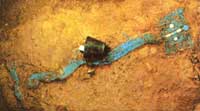
Turquoise model of "dragon"
discovered at the Erlitou Xia-Shang palace site,
Yanshi, Henan province
The Erlitou walled palace compound is the oldest "palace city" site found to date in China. Here archaeologists discovered the remains of tamped earthen walls, chariot tracks, turquoise objects and a turquoise workshop. The excavators estimate that the palace grounds cover more than 108,000 sq m, and are of a size appropriate to the capital city of a state. The ruts created by chariots are the oldest yet discovered by Chinese archaeologists, pushing back the history of two-wheeled vehicles in China to the early period of Erlitou culture. This is significant because it challenges the view that the chariot was introduced to China from the West.
4. Xiaohe cemetery site, Lop Nur, Xinjiang
Date: Bronze Age
Excavation team: Xinjiang Cultural Relics and Archaeology Institute
Leader of the excavation: Idresi Abdulres
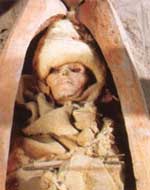
Well preserved female mummy
from the Xiaohe cemetery at Lop Nur, Xinjiang
Although the cemetery was surveyed in 1934 by Swedish archaeologist Folke Bergman, excavations were only initiated at the desert site in 2002. In four separate digs, archaeologists have unearthed 167 graves, from which more than a thousand articles have been recovered. More than 30 extremely well preserved mummies have been discovered. These graves are believed to date from as early as c. 1000 BCE.
5. Tanheli Western Zhou city site, Ningxiang county, Hunan province
Date: Western Zhou
Excavation team: Hunan Provincial Cultural Relics and Archaeology Institute
Leader of the excavation: Xiang Taochu
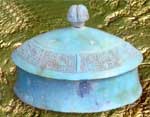
Lid of bronze you vessel
found at Western Zhou city site, Ningxiang, Hunan
This is the first Western Zhou walled town or city site found to date in Hunan, and one of only a few found throughout the south. Traces of walls, a moat and what might be palace foundations were uncovered. Archaeologists found seven aristocratic graves, from which they recovered a large quantity of bronze vessels and jade articles. These finds will be useful for examining the local bronze cultures of the Hunan region and their interaction with other contemporary bronze cultures.
6. Hongshan Yue state aristocrats' cemetery site, Wuxi city, Jiangsu province
Date: Spring and Autumn-Warring Kingdoms
Excavation team: Nanjing Museum Archaeology Institute and Wuxi Municipal Cultural Relics Management Committee for the Hongshan District
Leader of the excavation: Zhang Min
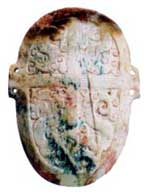
Jade face cover unearthed at the Yue aristocrats
cemetery in Hongshan, Wuxi
This is the first major Yue excavation since that in 1996-1998 of the massive royal grave of the Yue state at Yinshan, Shaoxing, Zhejiang. It has enabled archaeologists to study the layout of graves in aristocratic cemeteries, and to note that five ranks of nobility can clearly be discerned. More than 1,100 articles were found in grave no. 2. Of great importance are some of the finest and oldest funerary proto-celadon porcelain items found to date, including a number of proto-celadon ritual musical instruments. Some very fine jade wares (see illustration) and early glass items were also unearthed.
7. Sixteen Kingdoms-Three Yan period site of the Southern gate of Longcheng Palace, Chaoyang city, Liaoning province
Date: Sixteen Kingdoms period
Excavation team: Liaoning Provincial Cultural Relics and Archaeology Institute
Leader of the excavation: Tian Likun
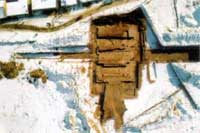
Aerial view of the entire excavation site
at the ancient gate in Chaoyang
This discovery is important for the light it casts on the city plan of Chaoyang in the Three Yan period. This gate was built in the Former Yan dynasty and endured through six dynasties down to the Mongol-Yuan dynasty. This excavation is invaluable for archaeologists studying city walls and ancient architecture because the gate is so well preserved.
8. Two Southern Han dynasty mausolea, Guangzhou University City, Guangdong province
Date: Five Dynasties and Ten Kingdoms period
Excavation team: Guangzhou Municipal Cultural Relics and Archaeology Institute
Leader of the excavation: Feng Yongqu
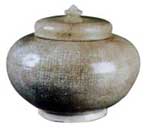
Celadon jar unearthed from the Deling
mausoleum in Guangzhou
This excavation of two Southern Han mausolea, named Kangling and Deling, in Guangzhou has provided valuable information for the history of burials in the Southern Han dynasty. Celadon jars and glazed pottery jars found in Deling represent the largest finds in Guangzhou of such wares produced at an official kiln. An inscribed stele was also discovered in Kangling which will lead to some aspects of Guangzhou's history being reworked.
9. Southern Song imperial road at Yanguan-xiang, Hangzhou, Zhejiang province
Date: Southern Song dynasty
Excavation team: Hangzhou Municipal Cultural Relics Conservation and Management Office
Leader of the excavation: Du Zhengxian
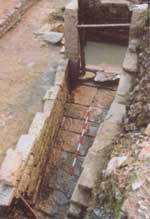
Water lock found
at the Southern Song imperial street site,
Yanguanxiang, Hangzhou, Zhejiang province
The excavation of this stone-paved imperial road, which once formed the central axis of the Southern Song dynasty capital Lin'an, has provided archaeologists with valuable information regarding engineering construction, architecture and urban layout in Song-dynasty Hangzhou. The remains of the causeway road include sections of a bridge, a lock (see illustration), and a retaining wall.
10. Jiannanchun distillery site, Chengguan-zhen, Jinzhu city, Sichuan province
Date: Qing-Republican period
Excavation team: Sichuan Provincial Cultural Relics and Archaeology Institute
Leader of the excavation: Chen De'an
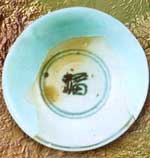
Ming dynasty blue-and-white bowl
bearing the character fu (happiness)
found at the distillery site in Jinzhu, Sichuan province
Although several ancient distilleries have been excavated in Sichuan over recent years, this is the most complete to have been excavated. The unearthed areas cover every stage of the distillation process. [BGD]
|